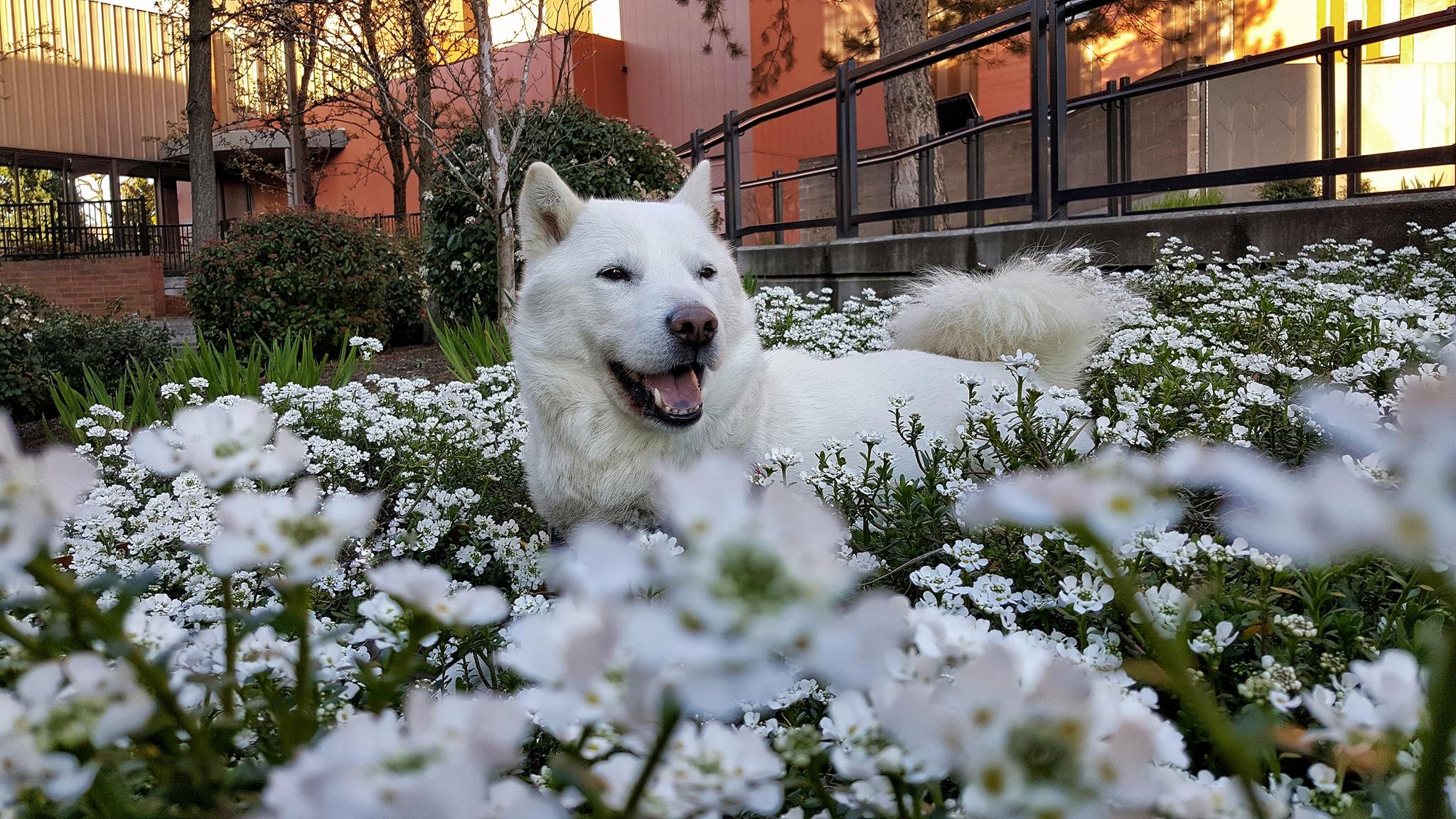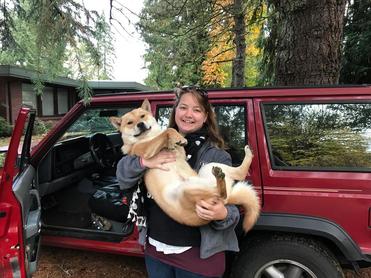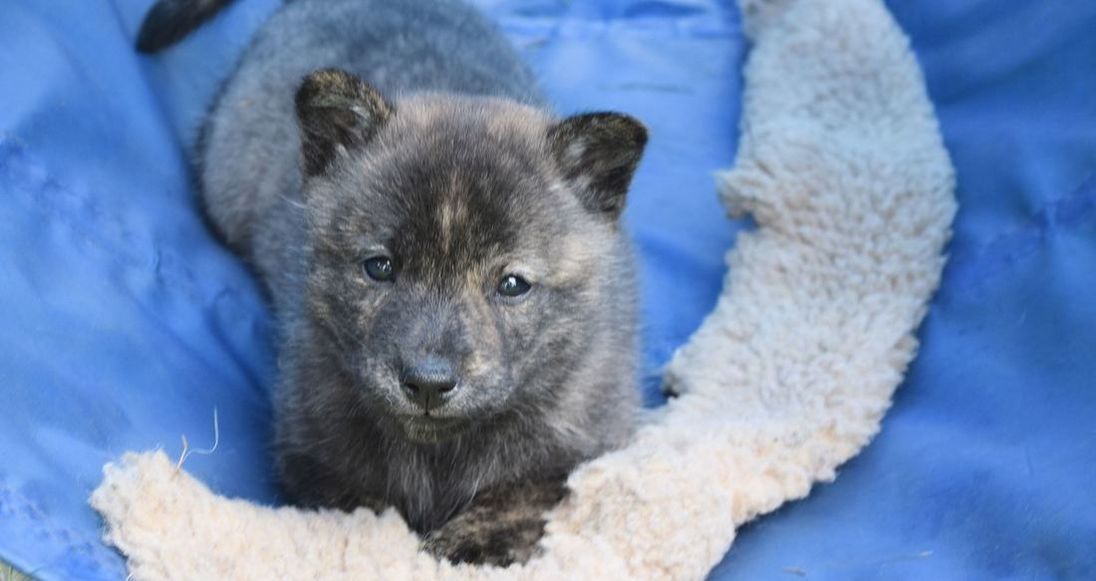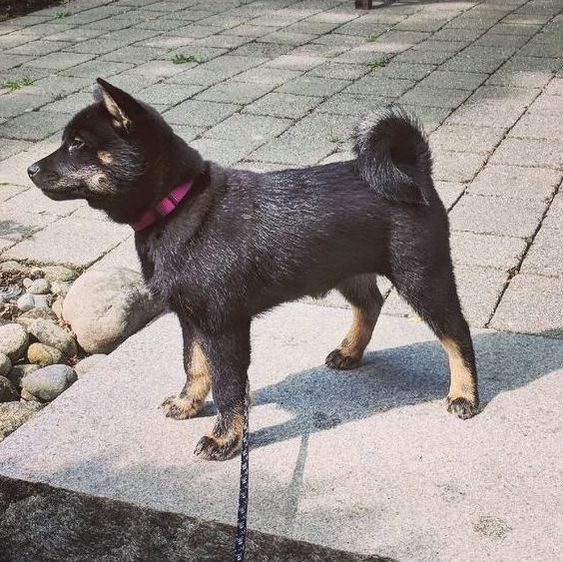The Hokkaido is a brave, devoted, and intelligent breed. They are one of the six native Japanese spitz breeds recognized as National Treasures of Japan. The breed descends from the medium-sized Japanese dogs that followed the Ainu migrants from Honshu, the largest of the Japanese islands, to Hokkaido, the northernmost island of Japan. The Ainu people used these dogs to hunt bear and other large game.
Today in Japan, although primarily kept as watch dogs and companions, Hokkaido are still tested against bears in a very controlled setting. Hokkaido have a physique that is well suited to working in extreme cold and heavy snow. They also display acute judgment and great stamina. The breed was declared a Natural Monument in 1937, when it was named after its native island. They are shown at Nippo events and there are at least two preservation societies within Japan.
Outside of Japan, Hokkaido are recognized by The United Kennel Club (UKC), Fédération Cynologique Internationale (FCI), and the American Kennel Club Foundation Stock Service program (AKC FSS®).

Hokkaido Temperament
With early socialization and training, the Hokkaido is a very loyal and dedicated companion who wants to please his human family. In the right situation, they make excellent family dogs. Hokkaido want to be with their owners at all times, taking part in whatever their human family is doing. They insist on following their owners from room to room in the house, and love nothing better than going along in the car on errands. Separation anxiety is something which has been observed my many Hokkaido owners.
Hokkaido are incredibly intelligent thinkers and problem solvers. They are a highly trainable breed, but only with the right handler who knows how to connect with the individual dog, as well as factor in the breed’s natural independence and strong will into training plans. Because of their independent and bold nature, the Hokkaido requires training and socialization from an early age. If not socialized properly, Hokkaido can become wary of strangers and protective of their families. Given their hunting background, Hokkaido can be small animal aggressive. While human aggression is rarely seen in Hokkaido, dog aggression (particularly seen in intact males) is fairly common.
Thus, HANA cannot stress enough the importance of early, positive socialization for your Hokkaido puppy!
The Hokkaido is also an active breed which needs a great deal of exercise on a daily basis to keep them fit and mentally sound. Because of their high energy and high intelligence level, the Hokkaido should be given a “job” to do. This doesn’t have to be hunting bear like they were bred for… truly, Hokkaido are a very versatile breed; excelling at activities such as hunting, agility, obedience, trick dog performance, and more.
Hokkaido Appearance
The Hokkaido has adapted over time to survive the severely cold and rugged Hokkaido landscape. Thus, they have developed thick weatherproof coats, large paws, small ears, powerful chests, strong jaws, and robust features.
The Hokkaido is a medium-sized dog, standing at 18-20 inches and 30-45lbs. They are slightly longer than tall, well-balanced, sturdily built, and well boned. Their muscles should be tough and clean cut. Bitches should appear feminine without looking slight of bone/muscle. The Hokkaido’s short double coat has harsh guard hairs with a very thick and soft undercoat, which does not require frequent bathing.
NIPPO, UKC, and FCI recognize the Hokkaido in five distinct color varieties: red, white, black & tan, brindle, and sesame. DOKENO allows for a sixth color: wolf grey. Colors not explicitly stated within the breed standards, but are still acceptable and should not be faulted include: solid black, brindle pointed black and tan, white chest splashes, and urajiro (white undertones). Colors which are acceptable but undesired in Japan include white with red tipping/shading, and sashige (red with black tipping). Pinto is a stated fault in every Hokkaido breed standard.
More detailed information on the Hokkaido’s appearance can be found on the breed standard page.
Life with a Hokkaido
Cleanliness
You may have heard of the Shiba Inu and how naturally clean the breed is (avoiding dirt and water at all costs.) However, the Hokkaido is quite the opposite. They are a fun breed. They enjoy spending time outside getting dirty, splashing in mud, swimming in creeks, and rolling in grass.
Grooming
When fed a proper diet, they have little to no doggy odor despite infrequent bathing. The Hokkaido is fairly self-managed breed. The natural oils on their skin and coat helps to keep them clean and dry despite unfavorable weather conditions. Hokkaido enjoy swimming in the creek and playing in the mud frequently. However, the water and the dirt just falls right off by the time you get home.
No trimming or shaving of their fur is required or recommended, just regular brushing to remove dead hair and keep the coat healthy. Absolutely under NO circumstances should you shave down your Hokkaido. It is incredibly damaging to their coat, and contrary to popular belief, it will NOT keep them cooler over the summer months.
Nails should be kept as short as possible (so you can’t hear them “click” as they walk on hard wood floors), preferably using a dremel nail grinder to round off the edges.
Like all spitz breeds, the Hokkaido are very heavy shedders. Especially with their thick, dense undercoat. Roughly twice a year (could be more, could be less depending on the climate where you live), the Hokkaido will “blow coat” and shed out all of their undercoat. This typically lasts several weeks. During this time, daily brushing is a must in order to help them remove all the dead hair and make way for their new coat to grow in. Apart from the twice-yearly “fur-pocalypse” when they are blowing coat, the Hokkaido does not shed much. During the summer months, the Hokkaido will probably prefer to sleep on tiled floors or next to cool air vents. During the winter, Hokkaido love to spend time outdoors in the cold.
House Manners
Hokkaido are not a clumsy breed, and they tend to be careful and sure-footed around furniture. There’s no need to worry about a rapidly swinging tail sweeping your mug off the coffee table, or a 50lb dog plowing into your kitchen island after running down the stairs.
Hokkaido are a very vocal breed though. They can make a wide variety of unique sounds, and they love to “talk” to their people. Whenever you arrive home, your Hokkaido will most likely burst into song. This can be quite loud and last for several minutes. Hokkaido will also howl, groan, or grumble in protest if given a command they do not wish to follow. They will roo at neighbors and friends who come into your home as well.
When exercised properly and given adequate mental stimulation, Hokkaido are not a destructive breed. However, a bored Hokkaido may take to chewing, escaping, howling, digging, etc.
Hokkaido tend to enjoy chewing (and sometimes ingesting) all sorts of non food items. This phenomenon is known as “pica” and it tends to be a familial disorder. Several Hokkaido in the US have been sent to the emergency room for ingesting rocks, socks, stick fragments, etc. It’s important to carefully supervise your Hokkaido when playing, and keep non-edible items off of the floor to prevent any mishaps.
Potty Training
Hokkaido are generally quick learning dogs, though potty training seems to be a challenge for some. Submissive peeing has also been observed by several Hokkaido owners in the US. Estimate approximately nine months to fully potty train your Hokkaido puppy. Owners should plan to have puppy potty breaks and exercise available at least every four hours until fully potty trained. Crate training your Hokkaido puppy is highly recommended to keep him out of trouble, but remembering to exercise him often is important.
Overall, Hokkaido make an excellent house dog given the family and right situation.





